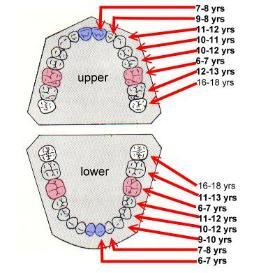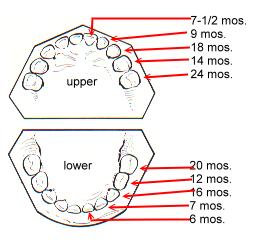|
|
|
The time of the first visit of the child to the dentist
Usually it happens around 2 years of age but it would be
best to bring them in as soon as you think they are old
enough to sit in a dentist's chair without being scared
enough to cry and scream. The parent Should accompany the
child into the operatory. In a majority of cases, children
do perfectly well with parents in the operatory. It is the
minority of cases that are the most difficult, and the ones
in which the parents are best asked to leave for the waiting
room.
The correct age for the child to start brushing
The moment the first tooth erupts in the oral cavity,
brushing should be started. Before that in infants , the gum
pads should be cleaned with a soft piece of cloth by the
parents.
Parents concerned about their child's oral health may do
some of the brushing for them, but it is always best not to
make it an unpleasant experience. The easiest way to
indoctrinate children in brushing is to let them watch you
do it on a regular basis and then encourage them to imitate
you when they show an interest.
Technique is not important at an early age. The point is to
get them to start to handle the toothbrush at an early age,
and to get them used to having one in their mouth.
The importance of Milk Teeth
Baby teeth are just as important as adult teeth, and must be
just as well protected from disease and made to stay in the
oral cavity.
Children need their teeth as much as we do to chew and
smile. If the teeth are lost early, the child will suffer
pain and an inability to eat properly will lead to poor
nutrition.
Though we as adults do not give it importance, but children
do have a social life and feel embarrassed to have missing
teeth. This might lead to psychological problems.
The baby teeth are essential for holding the spaces open so
that the adult teeth can come into the correct position when
they are finally developed.
The normal pattern of eruption of milk teeth
The child has 20 milk teeth. Over a period of time these 20
teeth will be replaced by 20 permanent teeth (incisors,
canines and pre molars) and 12 more teeth ( molars ) to have
a total of 32 permanent teeth.
The first teeth begin to erupt at about age 6 months and
continue until about age 24 months at which time all 20 of
the baby teeth are in place.
In general, the teeth erupt from the front to the back, and
the lowers come in about 2 to 6 months before the
corresponding upper teeth. The lower incisors are the first
teeth to erupt followed by upper front teeth.
If your child is late, don't worry. They may finish as much
as a year behind schedule.
If your child is missing one or more baby teeth, it does not
necessarily mean that she will be missing the corresponding
adult teeth. If some of the baby teeth are discolored or
misshapen, it does not usually indicate that there will be a
problem with the adult teeth.
The normal pattern of eruption of child’s adult teeth
The first adult tooth erupts even before the child has lost
the first baby tooth, at about age 6. They are the first
adult molars and they erupt behind the existing baby teeth.
At about the same time the lower baby central incisors will
loosen and fall out to allow the adult central incisors to
erupt. All the baby teeth should be gone, or the remaining
ones lost by age 12. The adult teeth that are forming under
them will continue to erupt through age 17 or 18 when the
wisdom teeth finally are supposed to erupt.
 
In some cases,
a baby tooth may remain in place even though the adult tooth
is erupting beside it. In this case, the baby tooth MUST
come out one way or another or it will interfere with the
positioning of the adult tooth. If the child cannot or will
not remove it herself by wiggling it, then take the help of
your dentist for an extraction.
The correct time for child to wear braces
Except the skeletal deformities, most of the malocclusions
in children can be prevented by interceptive orthodontics to
a large extent. So it becomes imperative to visit your
dentist the moment permanent teeth start to erupt and milk
teeth start to fall. It is essential that all children be
examined for orthodontic deformities by about the age of 7
when the most common skeletal deformities can most easily be
treated. Many of these problems are not apparent to the
parents, and require a dental exam to identify them. If need
be, orthodontics can be started as early as 8-9 years. Left
untreated, these deformities cause the child lots of
functional and esthetic problems in the years ahead.
One stage of development needs special comment because so
many parents mistake it for an orthodontic problem. It's
called the "ugly duckling" stage when there is a space
between the top central incisors. This is the norm between
ages 7 through 12 years of age, and usually is not connected
with a permanent space between the teeth.
Is it normal for children to grind their teeth at night?
It IS normal for children under the age of about 13 to grind
their teeth at night. It appears to serve two purposes.
Grinding places pressure on the roots of the baby teeth over
the developing adult teeth which stimulates resorption
(natural destruction) of the roots of the baby teeth. This
resorption is ultimately responsible for the shedding of the
baby teeth when the adult teeth are ready to erupt.
Grinding also helps the adult teeth to erupt into their most
stable positions in the dental arches.
|
|